
Torneko: The Last Hope is a 1999 role-playing video game for the PlayStation. The game was co-developed by Chunsoft and Matrix Software and published by Enix. In Japan, the game was ported to the Game Boy Advance in 2001.

Antarctic Adventure is a video game developed by Konami in 1983 for the MSX, and later for video game consoles, such as the Family Computer and ColecoVision. The player takes the role of an Antarctic penguin, racing to various research stations owned by different countries in Antarctica.

Taiko no Tatsujin is a Japanese video game series created by Namco. In the games, players simulate playing a taiko drum in time with music. The series has released games for the arcade and for console and mobile platforms including PlayStation 2, Advanced Pico Beena, PlayStation Portable, Nintendo DS, Wii, Nintendo 3DS, Wii U, PlayStation Vita, PlayStation 4, PlayStation 5, Nintendo Switch, Xbox One, Xbox Series X/S, Microsoft Windows, iOS, Android and Japanese feature phones.

Pinobee: Wings of Adventure, known in Japan as Pinobee no Daibōken or Pinobee: Quest of Heart, is a platformer for the Game Boy Advance, developed by Artoon and published by Hudson Soft. The game was released as a launch title for the system, on March 21, 2001 in Japan and June 11, 2001 in North America. A version was developed for PlayStation in 2002, simply titled Pinobee outside Japan.
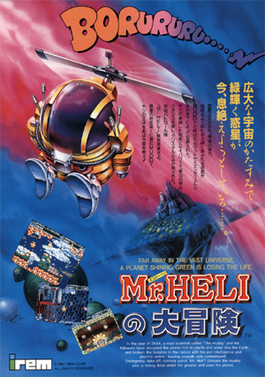
Mr. Heli, fully titled in Japan as Mr. HELI no Daibōken is a multidirectional scrolling shooter developed and published in arcades in 1987 by Irem. It was released in North America as Battle Chopper.
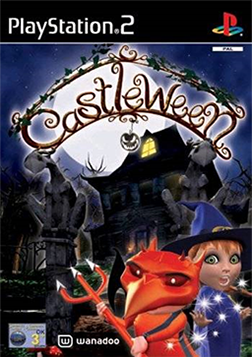
Castleween is the name of two 2002/2003 platform video games, one developed by Kalisto Entertainment for the PlayStation 2 and ported to the GameCube by Wanadoo Edition, and the other developed by Magic Pockets for the Game Boy Advance.

Liquid Kids is a 1990 platform arcade video game developed and published by Taito. Starring the hippopotamus Hipopo, players travel through the land of Woody-Lake throwing water bombs, jumping on and off platforms to navigate level obstacles while dodging and defeating monsters in order to rescue Tamasun from her captor, the Fire Demon. The game was ported to the PC Engine and Sega Saturn. Home computer versions were in development but none were officially released to the public.

Torneko's Great Adventure: Mystery Dungeon is a 1993 role-playing video game by Chunsoft. The first entry in the Mystery Dungeon series, the game features Torneko, a merchant from Dragon Quest IV, and his adventures around the Mystery Dungeon in search of items.

Dragon Quest Characters: Torneko's Great Adventure 3 – Mystery Dungeon is a 2002 role-playing video game developed by Chunsoft and Matrix Software and published by Enix for the PlayStation 2. It is part of the Dragon Quest and Mystery Dungeon series and contains randomly generated dungeons and uses turn-based action combat. The game was also made for the Game Boy Advance in 2004 as Torneko's Great Adventure 3 Advance.

Kowloon's Gate is a 1997 adventure video game published by Sony Music Entertainment. It was released for the PlayStation in Japan, but not in other regions.
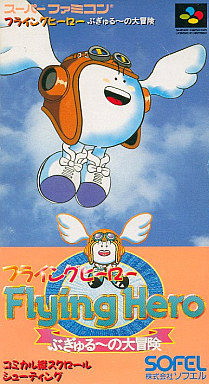
Flying Hero: Bugyuru no Daibouken is a vertically scrolling shooter developed by Sting Entertainment and published by SOFEL. It was released in Japan on December 18, 1992 for the Super Famicom. The game was not released in other countries.
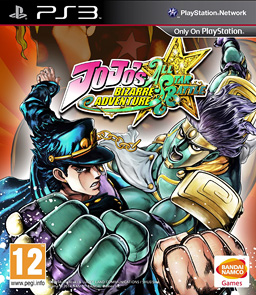
JoJo's Bizarre Adventure: All Star Battle is a fighting game developed by CyberConnect2 and published by Bandai Namco Entertainment for PlayStation 3. Based on Hirohiko Araki's long-running manga series JoJo' s Bizarre Adventure, the game allows players to compete against each other using 40 characters taken from the first eight story arcs, as well as one guest character from another manga also created by Araki. The game was released in Japan on August 29, 2013, and was released internationally in late April 2014.

The Idolmaster Shiny Festa is a series of three Japanese rhythm video games developed by Namco Bandai Studios and published by Namco Bandai Games. The games are part of The Idolmaster franchise, and were originally released on October 25, 2012 as Honey Sound, Funky Note, and Groovy Tune for the PlayStation Portable in Japan. They were the first games in the series to be localized into English, and were released for iOS on April 22, 2013 as Harmonic Score, Rhythmic Record, and Melodic Disc, while retaining their original names for the Japanese versions. Service for the iOS version was discontinued on March 15, 2016.

The Pokémon Mystery Dungeon: Adventure Team series are three role-playing games released for WiiWare, part of the Pokémon Mystery Dungeon series of games developed by Chunsoft and published by The Pokémon Company. The titles, which were released in Japan on 4 August 2009, are Pokémon Mystery Dungeon: Advance! Fire Adventure Team, Pokémon Mystery Dungeon: Go! Storm Adventure Team and Pokémon Mystery Dungeon: Aim! Light Adventure Team. This installment is the first game in the Mystery Dungeon series to be on a home system, with the next home installment being Pokémon Mystery Dungeon: Rescue Team DX for the Nintendo Switch.
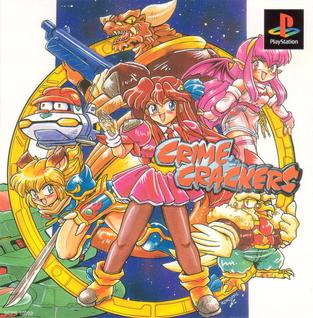
Crime Crackers is a 1994 action role-playing first-person shooter video game developed by Media.Vision and published by Sony Computer Entertainment for the PlayStation. Based on a science fiction manga set after an intergalactic war, the story follows of group of bounty hunters aboard the spacecraft Pink Dolphin as they take on jobs requested by the Galactic Federation police. Gameplay resembles dungeon crawlers, largely consisting of exploring complex 3D corridors, collecting items, and shooting enemies. The player is able to freely rotate between three unique characters within missions, while points earned afterwards can be used to purchase consumable items and upgraded equipment.

Athena: Awakening from the Ordinary Life is a 1999 Japanese video game developed by Yumekobo and published by SNK for the Sony PlayStation. The game stars SNK character Athena Asamiya, who is a normal Japanese high school student who suddenly learns psychic powers and thrust into a science fiction storyline. It is a three-dimensional adventure game where her psychic powers are used to solve puzzles and overcome obstacles. The game was never released outside of Japan. The game's plot was adapted into a 12-episode television series, titled Athena, in 1998.

Magical Drop F: Daibōken Mo Rakujyanai! is a 1999 puzzle video game by Data East for the PlayStation. It is the fourth entry in the Magical Drop series. In the game, the player takes control of one of several characters and battle against opponents. Gameplay is similar to previous entries but with the addition of an role-playing (RPG) mode; the player controls Justice on a journey to find seven Magical Drops scattered across the land, traveling villages and challenging characters in battles to obtain items and power-ups.


















